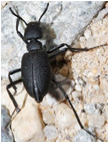 Cordylospasta opaca is a blister beetle that occurs in arid regions of Central and Southern California, including the Mojave Desert. It is large and black like similar blister beetles in the genus Meloe, ranging in size from one-third of an inch to an inch in length, though it is usually near the top of that length range. Unlike most Meloe genus beetles, the cordylospasta opaca has elytra, or forewings which encase the membranous hind wings, that entirely cover the abdomen.
Cordylospasta opaca is a blister beetle that occurs in arid regions of Central and Southern California, including the Mojave Desert. It is large and black like similar blister beetles in the genus Meloe, ranging in size from one-third of an inch to an inch in length, though it is usually near the top of that length range. Unlike most Meloe genus beetles, the cordylospasta opaca has elytra, or forewings which encase the membranous hind wings, that entirely cover the abdomen.
Cordylospasta opaca is of the family Meloidae, so called for their defensive secretion of a blistering agent, cantharidin.
Blister beetle eggs are laid by the female in protected areas like under stones. Blister beetles are hypermetamorphic, going through several larval stages, the first of which is typically a mobile triungulin. The larvae are insectivorous, mainly attacking bees, though a few feed on grasshopper eggs. The first blister beetle larval stage sports well-developed legs. The larvae often hitchhike on other insects like bees. The goal of the first larval stage is to locate a food source such as grasshopper eggs or bee nests in order to finish the rest of its development. The following larval stages are a different shape, more grublike, with fewer and shorter legs which results in them being not nearly as mobile. Many species of blister beetle survive the winter as late-stage larvae. The main goal of the larval stages is to grow as they feast upon their preferred food source. When they are ready to mature they will become pupae. The pupa stage is the transition stage where the grublike larva changes into the final adult stage. The adults then feed on flowers and leaves of plants of such diverse families as the Amaranthaceae, Asteraceae, Fabaceae, and Solanacea, mate and start the entire cycle over. Usually one generation of blister beetle is produced per year.
Blister beetles are softbodied beetles and are rarely any color other than black. They usually are seen during the day on flowers and also are attracted to lights at night. Blister beetles have an affinity for alfalfa and weeds during bloom.
Blister beetles produce cantharidin, a chemical which they employ as a means to defend themselves and their eggs. They release the chemical when agitated or attacked by predators.
Cantharidin is a vesicant, or in other words a chemical that causes irritations and blisters, hence the name blister beetle.
Historically, blister beetles have been used in medicine. Dead and dried beetles were smashed and ground into a fine powder. The powder was used to create a seemingly mystic folk medicine concoction called Spanish fly. When crushed, the beetle can literally bleed cantharidin from its joints. People used Spanish fly to treat physical ailments such as arthritis and more salaciously as an aphrodisiac. The basis for these uses is because consumption of Spanish fly results in irritation to the urinary tract which in turn can result in sexual stimulation. Despite this dubitable benefit, cantharidin also can have severe medical consequences and is widely viewed as a poison. The effects range from severe digestive issues, like diarrhea, to internal bleeding and kidney failure to possible death. Symptoms of poisoning can include stomach pain, nausea, vomiting, bloody urine and possible coma.
One documented use of cantharidin is to remove warts. It has also been used for treating such ailments as gout and arthritis, though because of its toxicity, it is no longer widely used in medicine.
Blister beetles are not an indoor infesting pest.
SBCSentinel
News of note from around the largest county in the lower 48 states.
